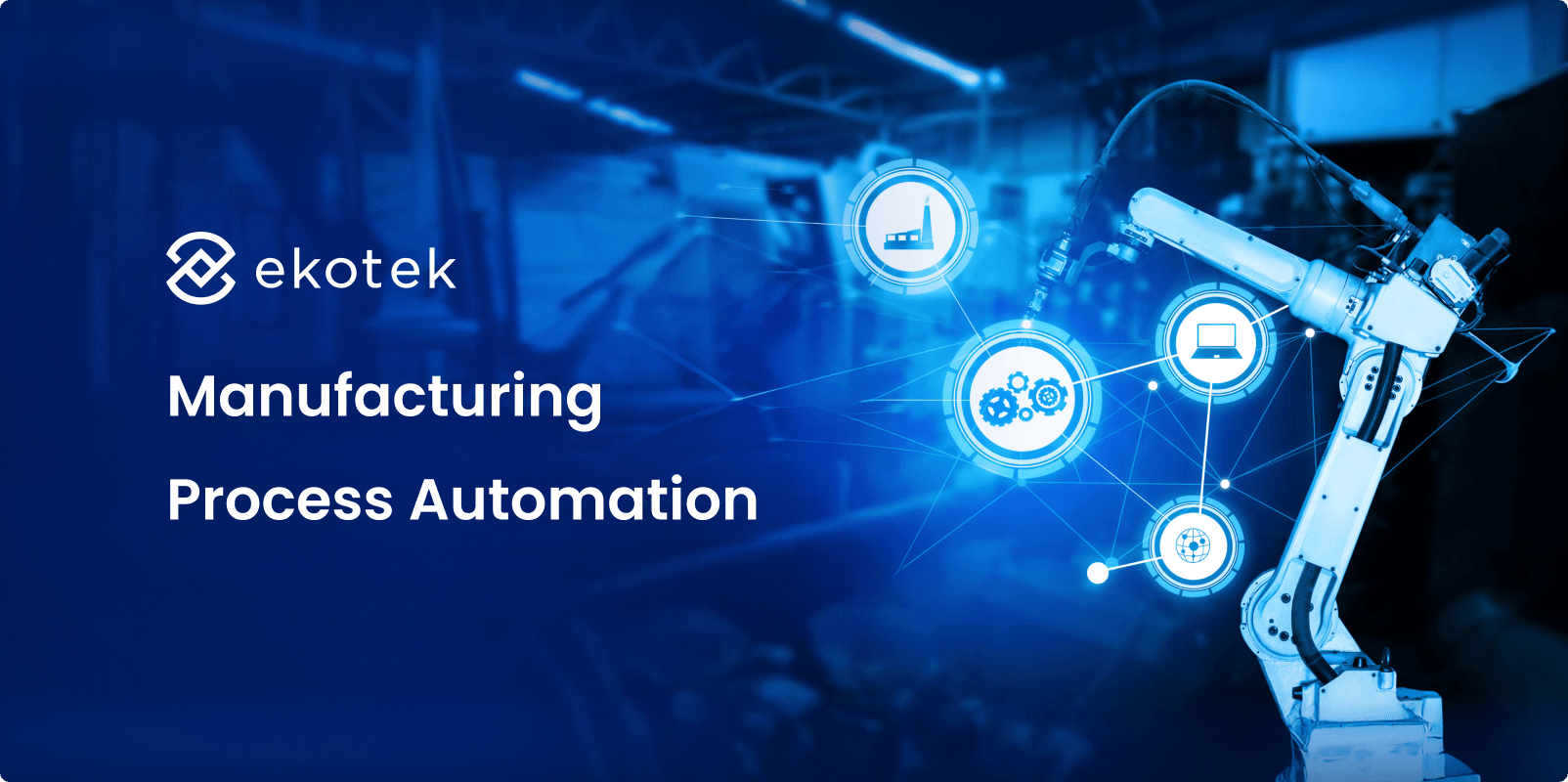
- 1
- 2
- 3
- 4
- 5
- 6
- 7
- 8
- 9
- 10
Introduction
Global manufacturing is undergoing a profound transformation, driven by powerful forces such as labor shortages, the rise of Industry 4.0, increasing demand for mass customization, and the need for greater agility in volatile global markets. According to a 2024 McKinsey report, 70% of manufacturers worldwide plan to increase automation spending over the next 2 years.
In this blog, we’ll guide you through everything you need to know about manufacturing process automation. You’ll learn about the different types of automation, the key benefits for modern factories, and practical steps to get started with automation in your own plant.
What is manufacturing process automation?
Manufacturing process automation is the use of integrated machinery, robotics, control systems, and software to execute production processes with minimal or no human intervention. By combining physical equipment with digital intelligence, automation helps manufacturers streamline tasks such as material handling, assembly, inspection, quality control, and tracking, improving both efficiency and consistency.
Traditional manufacturing relies heavily on manual labor or semi-automated machines, where operators perform repetitive tasks and manage processes with limited data visibility. This often results in inconsistencies, slower production cycles, and greater potential for human error.
In contrast, automated manufacturing uses smart machines and real-time data systems to perform production steps with high precision and consistency. These systems can adapt dynamically, reduce cycle times, and provide end-to-end visibility across the entire manufacturing process.
| Aspect | Manual/Semi-automated | Fully Automated |
|---|---|---|
| Labor Dependency | Heavy reliance on human labor | Machines handle most processes |
| Variability & Errors | High variability, prone to errors | Consistent and precise |
| Scalability | Limited, labor-intensive | Easily scalable with minimal overhead |
| Data Visibility | Minimal, often paper-based | Real-time digital dashboards |
⭐️ Dive into: A Comprehensive Guide on Digital Transformation in Manufacturing
The different types of automation in manufacturing
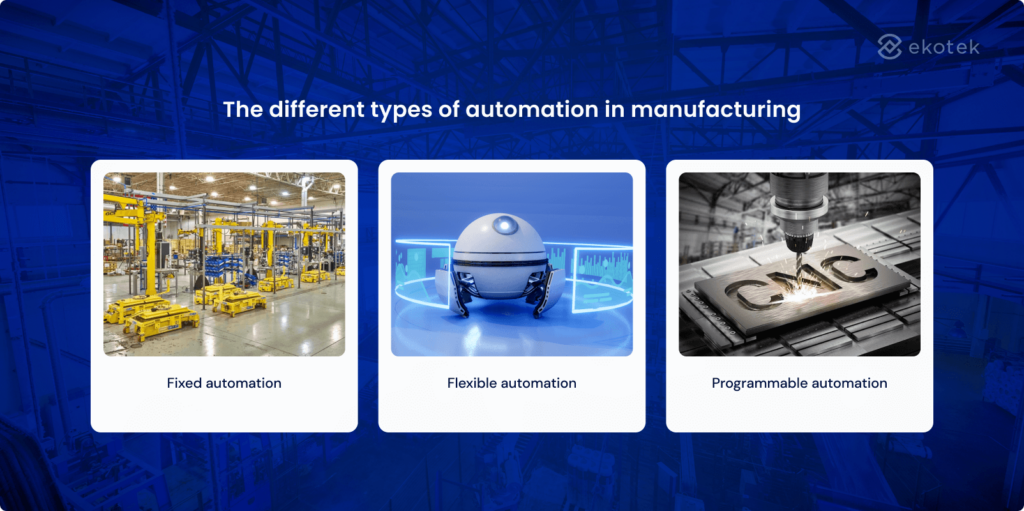
Fixed (hard) automation
Fixed automation is designed for high-volume production of a single product or a very limited product range. The equipment is custom-built for specific tasks and operates at high speed with minimal variation. This type of automation is ideal when the production process remains unchanged for long periods.
| Pros | Cons |
|---|---|
| Extremely fast, high output | Low flexibility, not suitable for varied products |
| Highly consistent product quality | Costly and time-consuming to reconfigure |
| Low unit cost at large volumes | High upfront capital investment |
Flexible (soft) automation
Flexible automation enables rapid changeovers and supports small-batch or highly customized production. Using robotics, AI, machine vision, and modular cells, flexible systems can adapt to different products on the fly, making them a core enabler of Industry 4.0 and smart factories.
| Pros | Cons |
|---|---|
| Adapts quickly to product changes | Higher initial complexity and integration cost |
| Enables mass customization | Requires advanced technologies (AI, robotics) |
| Ideal for small-batch and high-mix production | More demanding in terms of system design |
Programmable automation
Programmable automation is used for batch production, where product designs may change periodically. The equipment (such as CNC machines or programmable robots) can be reprogrammed between production runs, offering more flexibility than fixed automation.
| Pros | Cons |
|---|---|
| Flexibility to handle product variations | Downtime required for reprogramming |
| Suitable for medium-volume production | Not as fast as fixed automation |
| Lower cost than fully flexible systems | Requires skilled programming |
Key benefits of manufacturing process automation
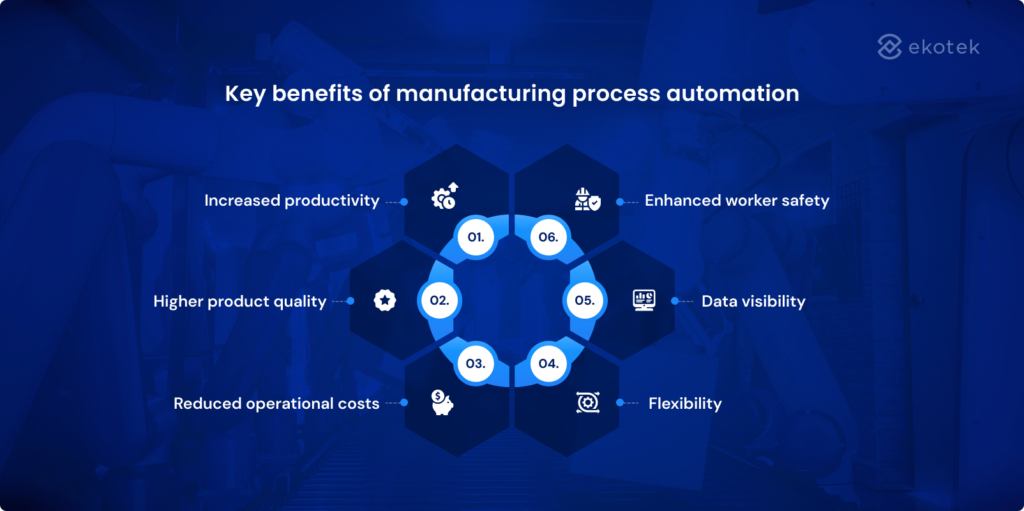
Increased productivity
Automation allows production to run at higher speeds and longer hours, far beyond the capabilities of human labor.
- Robots operate 24/7 without fatigue, allowing cycle times to be reduced by 30–50% compared to manual operations.
- Legacy system integration ensures that data flows seamlessly between existing ERP, MES, and modern digital tools, reducing delays caused by data silos and manual input.
⭐️ Read more case study: legacy migration for a logistics company
Higher product quality
Automated systems improve consistency and reduce the risk of human error, leading to higher and more predictable product quality:
- Computer vision systems can inspect products with 99%+ accuracy, detecting subtle defects that might be missed by human inspectors.
- Programmable Logic Controllers (PLCs) tightly control production variables, ensuring precise tolerances and consistent product specifications across every batch.
Reduced operational costs
While automation requires upfront investment, it significantly lowers operating costs over time by reducing labor, waste, and energy usage.
- Fewer operators are needed for repetitive or dangerous tasks, freeing up the workforce for more value-added roles.
- AI-powered anomaly detection and predictive analytics can help identify inefficiencies or equipment issues before they escalate.
- Data-driven process optimization helps manufacturers fine-tune energy consumption, material usage, and overall equipment effectiveness (OEE), lowering operational expenses.
⭐️ Want deeper insights on AI integration? Explore our AI Integration guide for your business.
Enhanced worker safety
Automation can take on tasks that are hazardous, physically strenuous, or ergonomically challenging, making the workplace safer for employees.
- Robots can handle tasks like welding, heavy lifting, and working with toxic materials, minimizing the risk of injury.
- Digital systems improve transparency and allow for predictive maintenance, reducing the risk of equipment-related incidents.
Data visibility
Automated systems provide rich real-time data that supports better decision-making and continuous improvement.
- Manufacturing Execution Systems and SCADA dashboards display key performance indicators like OEE (Overall Equipment Effectiveness), throughput, and downtime causes in real time.
- Blockchain-based traceability can add transparency across the supply chain, valuable for industries like food & beverage, pharmaceuticals, and precision manufacturing.
⭐️ Explore more: How Ekotek helped a manufacturer integrate Power BI for enhanced data tracking
Flexibility
Modern automation enables manufacturers to quickly adapt to changing product demands and market trends.
- Modular robotic cells allow for fast changeovers, so production can shift between product lines in minutes rather than hours.
- Configurable automation platforms and integrated AI agents can dynamically adjust production schedules based on live sales forecasts or order changes.
Key technologies driving automation
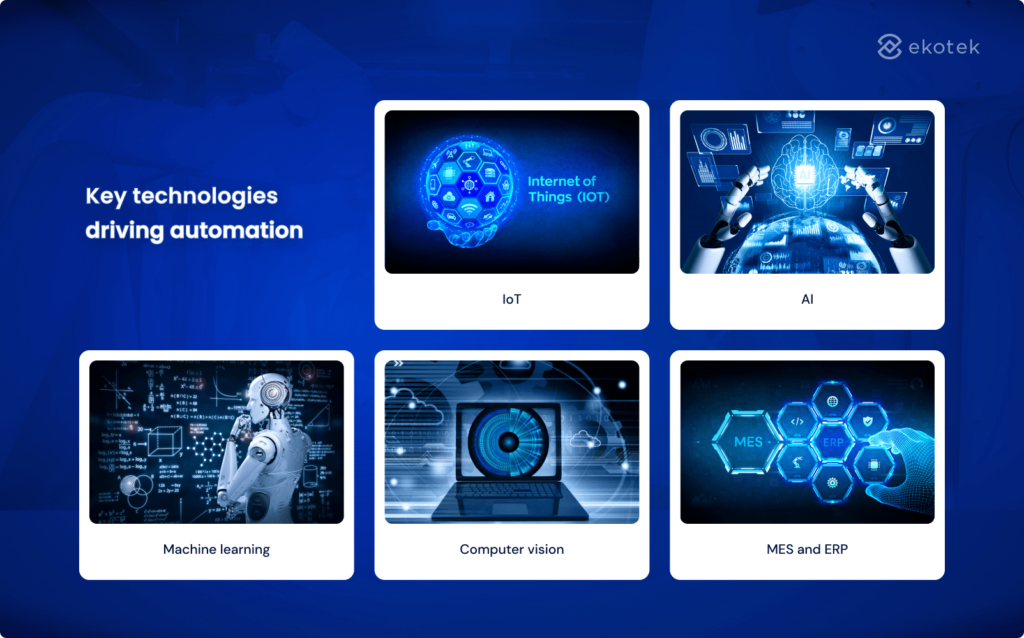
IoT sensors and real-time monitoring
IoT sensors are embedded across machines and production lines to continuously collect data on equipment health, process variables, and environmental conditions.
- Vibration, temperature, pressure, and ultrasonic sensors provide early warning of equipment wear or abnormal process variations.
- Industrial IoT (IIoT) platforms aggregate and analyze this data in real time, allowing operators to monitor production performance and detect issues before they cause downtime.
Artificial Intelligence (AI)
AI adds a layer of intelligence to automated systems by analyzing large volumes of production data and making smart decisions to optimize operations.
- AI can dynamically optimize production scheduling, adjusting line speeds or resource allocation to meet demand and reduce bottlenecks.
- AI-powered vision systems detect subtle defects in milliseconds, enabling real-time quality control that improves yield and reduces scrap.
⭐️ You may think of AI Outsourcing
Machine Learning (ML)
ML, a subset of AI, enables systems to learn from historical data and continuously improve performance.
- Predictive maintenance models use sensor data to identify patterns that precede equipment failure, enabling maintenance to be performed before breakdowns occur, reducing unplanned downtime.
- Process optimization algorithms analyze production trends to suggest adjustments that improve efficiency, maximize throughput, and minimize waste.
Computer vision
Computer vision systems use 2D and 3D cameras combined with AI to inspect products and guide robotic systems with high precision.
- Cameras ensure dimensional accuracy, surface quality, and correct part orientation, which is critical in industries like automotive, electronics, and medical devices.
- Integrated with robotic arms, computer vision enables precise pick-and-place tasks, even when handling delicate or irregularly shaped components.
⭐️ Have a look at How Computer Vision Is Disrupting Industries
MES and ERP integration
For automation to deliver maximum value, it must be connected to higher-level business systems, this is where MES and ERP integration comes in.
- MES tracks work-in-progress, collects real-time shop floor data, and manages production workflows.
- ERP systems synchronize this data with inventory, finance, procurement, and supply chain operations, creating a unified, real-time view of the entire business.
Common use cases in manufacturing process automation
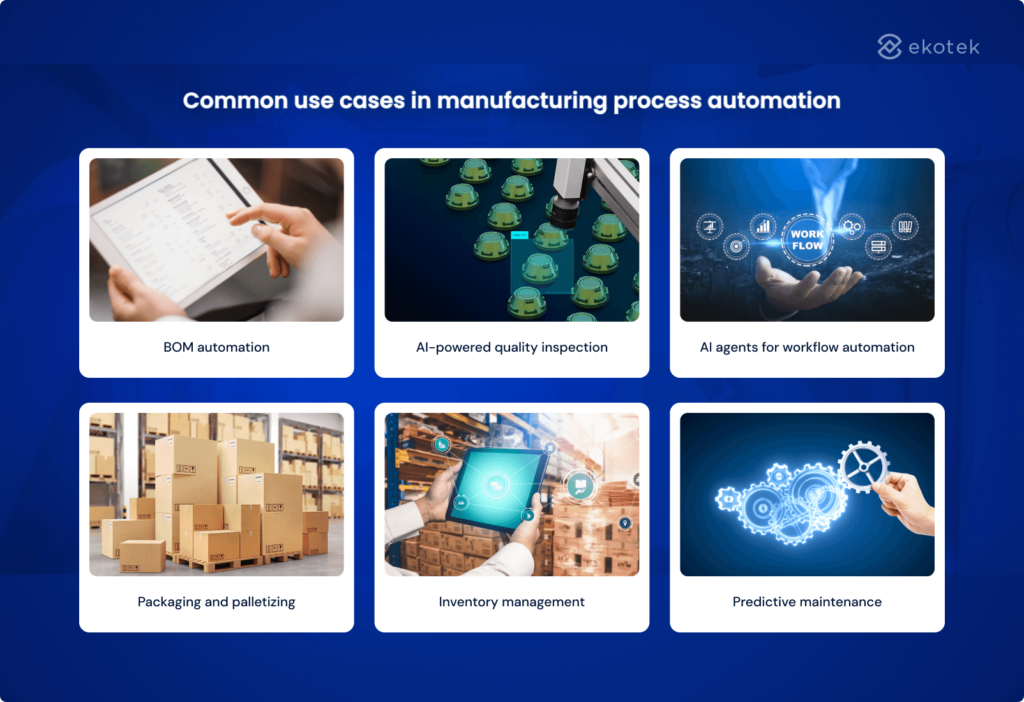
BOM automation
Automating BOM creation improves accuracy and accelerates production planning by reducing manual data extraction from complex documents.
- Computer vision identifies product components from technical drawings and images
- AI agents validate and populate structured BOMs into ERP or PLM systems.
A real-world example is Ekotek’s AI-powered BOM automation for a global footwear manufacturer. To streamline this, Ekotek built a tailored AI agent that combines:
- Computer vision: Recognizes and segments shoe components (uppers, soles, linings) from technical drawings and images.
- NLP: Extracts material data from unstructured documents like PDFs and supplier catalogs.
Results:
- Less manual work for engineering teams
- Higher BOM accuracy
- Faster production planning cycles
⭐️ Learn more: How our AI agent works
AI-powered quality inspection
Manual inspection is time-consuming and can miss subtle defects. AI-driven computer vision enhances quality control with faster, more consistent results.
- Computer vision systems detect surface defects, dimensional errors, and labeling issues in real time.
- AI models adapt to product variations and improve over time.
- Inspection results are integrated into quality dashboards for continuous monitoring.
AI agents for workflow automation
Manufacturing generates large volumes of data across systems. AI agents automate routine workflows and enhance real-time decision-making.
- Monitor production KPIs and trigger alerts for anomalies.
- Automate shift reports, production summaries, and routine documentation.
- Support dynamic scheduling based on live order and production data.
Packaging and palletizing
Packaging is often a bottleneck in manufacturing, automation can make this step faster, more consistent, and less labor-intensive.
- Vision-guided robots can identify and pick products, then pack them into boxes or trays, adapting to different product sizes and orientations.
- Automated palletizing systems stack finished boxes onto pallets with high speed and accuracy.
Inventory management
Manual inventory management is prone to errors and slow updates. Automated systems ensure real-time visibility and accurate stock tracking.
- Automated Storage and Retrieval Systems (AS/RS) can store, retrieve, and track raw materials, components, or finished goods with high precision, helping reduce space usage and picking errors.
- RFID tags and IoT-enabled scanners provide real-time tracking of inventory locations, movement, and stock levels, supporting just-in-time production and reducing inventory carrying costs.
Predictive maintenance
Unexpected equipment failures can cause costly downtime. Predictive maintenance uses automation and data to detect early warning signs and schedule maintenance proactively:
- IoT sensors monitor equipment parameters such as vibration, temperature, lubrication levels, and motor current, detecting anomalies that signal potential problems.
- Machine learning models analyze this sensor data to predict when components (such as bearings or motors) are likely to fail, allowing maintenance to be performed before breakdowns occur, reducing downtime and repair costs.
Challenges and considerations
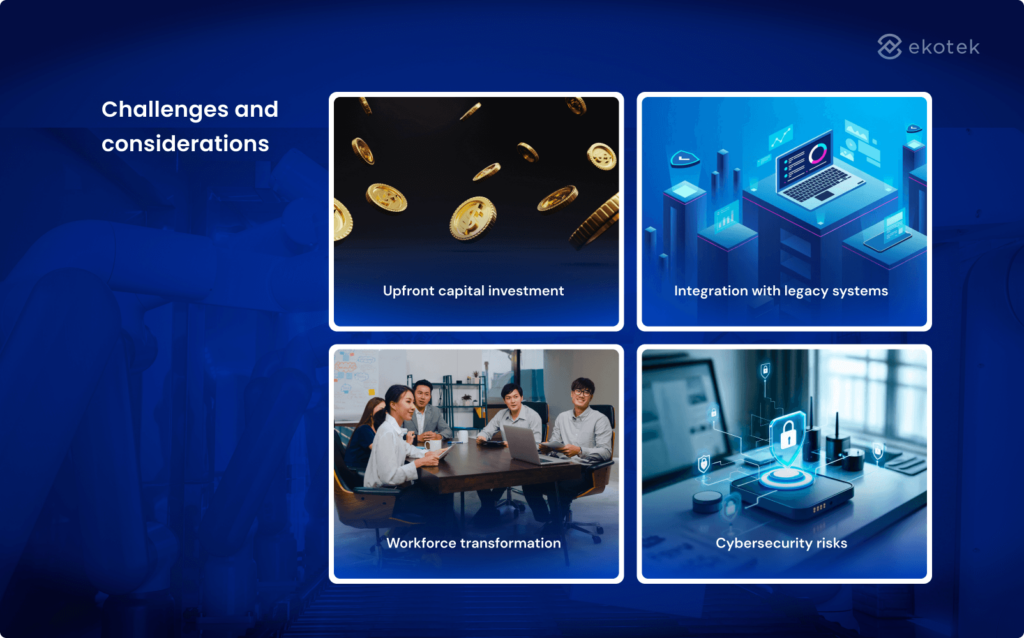
Upfront capital investment
Purchasing industrial robots, PLCs, vision systems, and integrating them with existing operations can require investments that run into six figures per line. To make informed decisions, companies must conduct a thorough ROI analysis, taking into account potential gains in productivity, quality, and cost savings over time.
Integration with legacy systems
Many manufacturing environments still rely on legacy equipment that wasn’t built to communicate with modern automation platforms. Without proper integration, these older machines can create data silos that disrupt end-to-end visibility. Often, manufacturers must invest in retrofitting machines or deploying middleware solutions to bridge the gap between legacy equipment and newer digital systems.
Workforce transformation
As machines take over repetitive tasks, human workers need to transition into more advanced roles such as robot programming, systems monitoring, and data-driven decision making. This transformation requires companies to invest in employee training and change management to build a future-ready workforce and foster a culture of innovation.
Cybersecurity risks
Every connected device presents a potential entry point for cyberattacks that can disrupt production or compromise sensitive data. To mitigate these risks, manufacturers must adopt robust cybersecurity practices, including network segmentation, industrial firewalls, VPNs, and regular security audits.
How to get started with manufacturing process automation
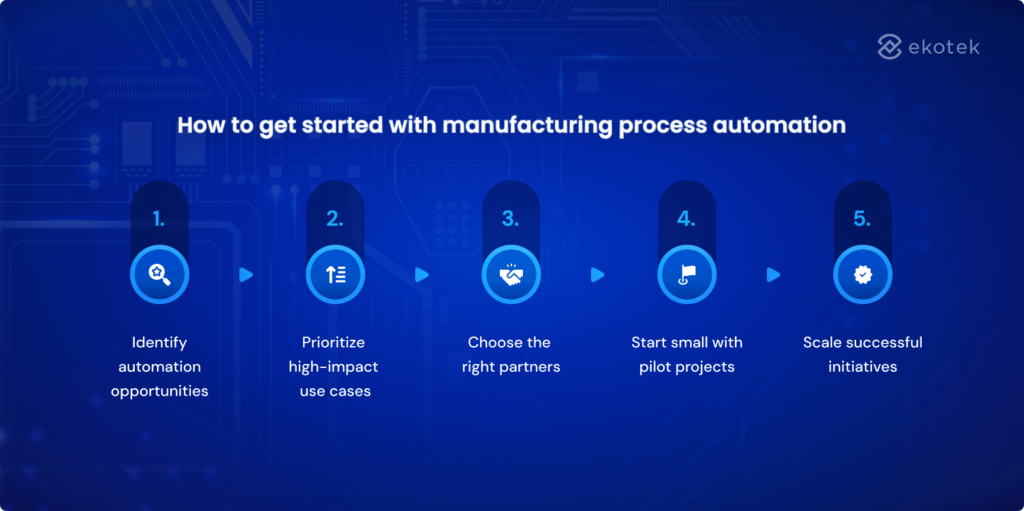
Step 1: Identify automation opportunities
The first step is to conduct a thorough audit of your current manufacturing processes. Map out workflows across your entire plant and identify areas with high levels of manual labor, repetitive tasks, quality issues, or production bottlenecks. Use real data, such as downtime logs, scrap rates, and labor hours, to prioritize which processes would benefit most from automation.
Step 2: Prioritize high-impact use cases
Once opportunities have been identified, focus on the ones that will deliver the greatest business value. Rank potential projects based on ROI potential, payback period, and technical complexity. In many cases, automating a production bottleneck or a high-scrap process will generate faster returns than trying to fully automate a low-volume line.
Step 3: Choose the right partners
Building an in-house automation team can be costly, time-consuming, and may lack the breadth of expertise required for complex manufacturing environments.
Partnering with experienced external providers offers significant advantages, from access to the latest technologies and cross-industry best practices to faster implementation and reduced risk. Consider outsourcing to partners who specialize in digital transformation services for manufacturing, such as Ekotek, to accelerate your automation journey and ensure long-term scalability.
Step 4: Start small with pilot projects
Rather than automating the entire factory at once, start with a pilot project, such as a single automated cell or line. This allows you to validate the concept, measure actual gains in cycle time, cost, and refine your approach.
Step 5: Scale successful initiatives
After a successful pilot, develop a plan to scale automation across multiple lines or plants. Standardize your automation architecture and ensure seamless data connectivity across equipment, MES, and ERP systems. Establish a Center of Excellence (CoE) to drive governance, maintain cybersecurity best practices, and continuously improve and expand automation efforts over time.
Ekotek’s digital transformation services for your manufacturing process automation journey
Ekotek provides a full range of DX services to help manufacturers automate and optimize their operations:
- AI integration and process automation: We apply AI to streamline manufacturing processes, reduce manual work, and improve accuracy and efficiency.
- System modernization and innovation: We help upgrade legacy systems with modern, cloud-based, API-first architectures, enabling seamless data flow and integration.
- Custom enterprise management systems: We design and build ERP, MES, DMS, CRM systems tailored to manufacturing needs, supporting better workflow automation.
- User-facing apps and new business models: We develop user-centric applications to support new digital services and business models for manufacturers.
Our modular and flexible approach ensures that each solution is tailored to the client’s needs, whether you’re starting small with a specific automation use case or pursuing full-scale digital transformation.
Final thoughts
Manufacturing process automation is no longer a nice-to-have, it’s a strategic driver for manufacturers aiming to stay competitive, agile, and data-driven. By embracing AI, intelligent automation, and modern system integration, manufacturers can unlock faster production cycles, higher product quality and consistency and lower operational costs.
As a trusted digital transformation partner, Ekotek helps manufacturers accelerate automation and modernize operations with deep cross-domain expertise. Our streamlined workflows and rigorous quality standards ensure fast, reliable project delivery. Backed by a scalable delivery model and a strong partner network, we support clients from pilot initiatives to large-scale transformation.
- 1
- 2
- 3
- 4
- 5
- 6
- 7
- 8
- 9
- 10